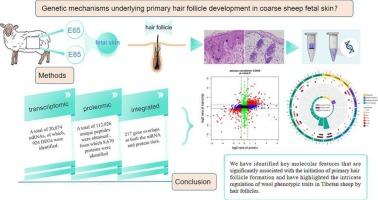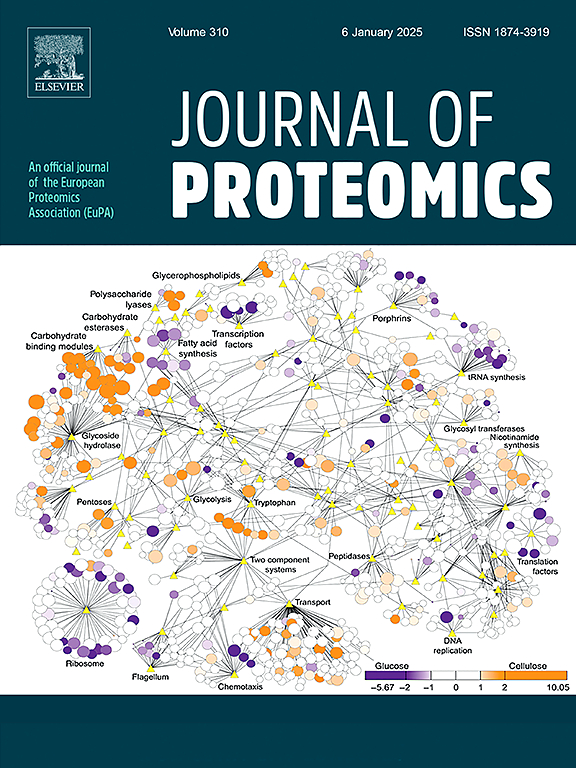Proteo-transcriptomic profiles reveal genetic mechanisms underlying primary hair follicle development in coarse sheep fetal skin
IF 2.8
2区 生物学
Q2 BIOCHEMICAL RESEARCH METHODS
引用次数: 0
Abstract
Long hair trait represents a valuable genetic asset in Qinghai Tibetan sheep, with its quality and yield being contingent upon the characteristics of hair follicles (HFs). This study aims to elucidate the genetic mechanism underlying primary hair follicles (PFs) formation through an integrated analysis of proteomics and transcriptomics. Samples were collected at key stages of fetal HF formation (E65 and E85) for histological observation, revealing significant alterations in the microstructure of PF (E65) during the developmental process. In this study, a comprehensive analysis revealed a total of 217 overlapping genes that exhibited concordant expression patterns at both the proteomic and transcriptomic levels. Furthermore, to ensure the reliability of our findings, we employed parallel response monitoring (PRM) to validate the obtained proteomic data. The protein-protein interaction (PPI) network diagram highlights five hub core proteins (TTN, IGTA2, F2, EGFR, and MYH14). These differentially expressed proteins (DEPs) play crucial roles in metabolic processes, cell adhesion, and diverse biological processes. The potential synergy between transcriptional regulation and post-translational modifications plays a pivotal role in governing the initiation PF development. The findings presented in this study offer innovative insights into the molecular mechanisms underlying HFs generation and establish a robust foundation for targeted breeding strategies aimed at augmenting wool traits in sheep.
Significance
The composition of coarse hair primarily consists of long, myelinated fibers originating from primary hair follicles. Sheep fetal skin initiates the formation of primary hair follicles around E65, followed by the development of secondary hair follicles around E85. Conducting differential proteomic and transcriptomic analyses during these developmental stages enhances our understanding of the molecular mechanisms underlying primary hair follicle development and offers valuable insights for sustainable utilization of high-quality germplasm resources.

蛋白质转录组图谱揭示粗毛绵羊胎儿皮肤初级毛囊发育的遗传机制
长毛性状是青海藏羊的宝贵遗传资产,其质量和产量取决于毛囊(HFs)的特性。本研究旨在通过蛋白质组学和转录组学的综合分析,阐明初级毛囊(PFs)形成的遗传机制。研究人员在胎儿毛囊形成的关键阶段(E65 和 E85)采集样本进行组织学观察,结果发现在发育过程中,胎儿毛囊(E65)的微观结构发生了显著变化。在这项研究中,通过综合分析发现共有 217 个重叠基因在蛋白质组和转录组水平上表现出一致的表达模式。此外,为了确保研究结果的可靠性,我们采用了平行响应监测(PRM)来验证所获得的蛋白质组数据。蛋白-蛋白相互作用(PPI)网络图突出显示了五个中心核心蛋白(TTN、IGTA2、F2、表皮生长因子受体和 MYH14)。这些差异表达蛋白(DEPs)在代谢过程、细胞粘附和多种生物过程中发挥着关键作用。转录调控和翻译后修饰之间的潜在协同作用在调控 PF 发育的启动过程中发挥着关键作用。本研究的发现为高频毛发的分子机制提供了创新性的见解,并为旨在增强绵羊羊毛性状的定向育种策略奠定了坚实的基础。绵羊胎儿皮肤在 E65 左右开始形成初级毛囊,随后在 E85 左右形成次级毛囊。在这些发育阶段进行不同的蛋白质组和转录组分析,可加深我们对初级毛囊发育的分子机制的了解,并为可持续利用优质种质资源提供宝贵的见解。
本文章由计算机程序翻译,如有差异,请以英文原文为准。
求助全文
约1分钟内获得全文
求助全文
来源期刊

Journal of proteomics
生物-生化研究方法
CiteScore
7.10
自引率
3.00%
发文量
227
审稿时长
73 days
期刊介绍:
Journal of Proteomics is aimed at protein scientists and analytical chemists in the field of proteomics, biomarker discovery, protein analytics, plant proteomics, microbial and animal proteomics, human studies, tissue imaging by mass spectrometry, non-conventional and non-model organism proteomics, and protein bioinformatics. The journal welcomes papers in new and upcoming areas such as metabolomics, genomics, systems biology, toxicogenomics, pharmacoproteomics.
Journal of Proteomics unifies both fundamental scientists and clinicians, and includes translational research. Suggestions for reviews, webinars and thematic issues are welcome.
 求助内容:
求助内容: 应助结果提醒方式:
应助结果提醒方式:


